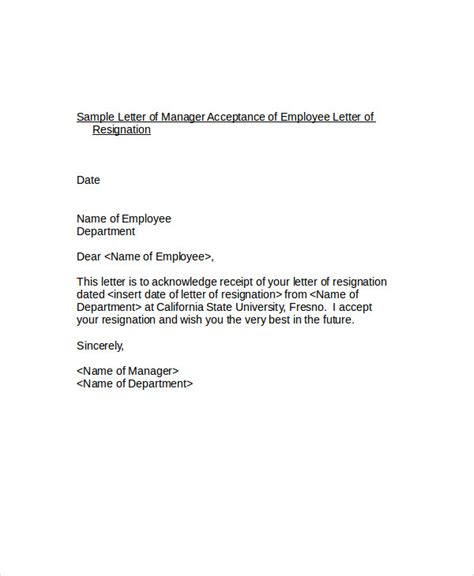Sample Letters Accepting An Employee's Resignation

When an employee resigns, it can be challenging to find the right words to say to them. While you may feel disappointed or even upset, it’s important to handle the situation professionally. Writing a letter accepting an employee’s resignation is an essential part of the process. Here are some tips to help you draft a letter that is both gracious and professional.
1. Begin with a Positive Tone
Start your letter on a positive note. Thank the employee for their contributions to the company and acknowledge their hard work. This will help to create a positive tone for the rest of the letter.
2. Acknowledge the Resignation
In your letter, you should acknowledge the employee’s resignation. This will show that you have received their notice and are aware of their decision. You can also use this as an opportunity to wish them well in their future endeavours.
3. Provide Details on the Resignation Process
It’s important to provide the employee with details on the resignation process. This may include information on their final paycheck, benefits, and any other relevant information. This will ensure that the employee is aware of what to expect during the resignation process.
4. Offer Assistance
If the employee needs any assistance during the resignation process, offer your help. This may include providing a reference or helping them to find a new job. This will show the employee that you are supportive of their decision and willing to help in any way you can.
5. End on a Positive Note
End your letter on a positive note. Reiterate your thanks for the employee’s contributions and wish them well in their future endeavours. This will help to maintain a positive relationship between the company and the employee.
6. Provide Contact Information
Finally, provide contact information for the employee to use if they have any questions or concerns. This will show that you are available to help if needed and will ensure that the employee has a way to contact you if necessary.
Conclusion
Writing a letter accepting an employee’s resignation can be challenging, but it’s an essential part of the process. By starting on a positive note, acknowledging the resignation, providing details on the resignation process, offering assistance, ending on a positive note, and providing contact information, you can create a letter that is both gracious and professional. Remember, it’s important to maintain a positive relationship between the company and the employee, even after they have resigned.
FAQs
Q: What should I include in a letter accepting an employee’s resignation?
A: In your letter, you should begin with a positive tone, acknowledge the resignation, provide details on the resignation process, offer assistance, end on a positive note, and provide contact information.
Q: Why is it important to maintain a positive relationship with the employee after they have resigned?
A: Maintaining a positive relationship with the employee can help to ensure that they speak positively about the company to others. This can be especially important if the employee is in a position of influence or has a large network.
Q: Should I offer a counteroffer to the employee?
A: It is ultimately up to the company to decide whether or not to offer a counteroffer. However, it’s important to consider the reasons for the employee’s resignation and whether or not a counteroffer would be in the best interests of the company.
Q: How should I address the employee in the letter?
A: Address the employee using their proper name and title. If you have a close relationship with the employee, you may also choose to use a more informal tone.
